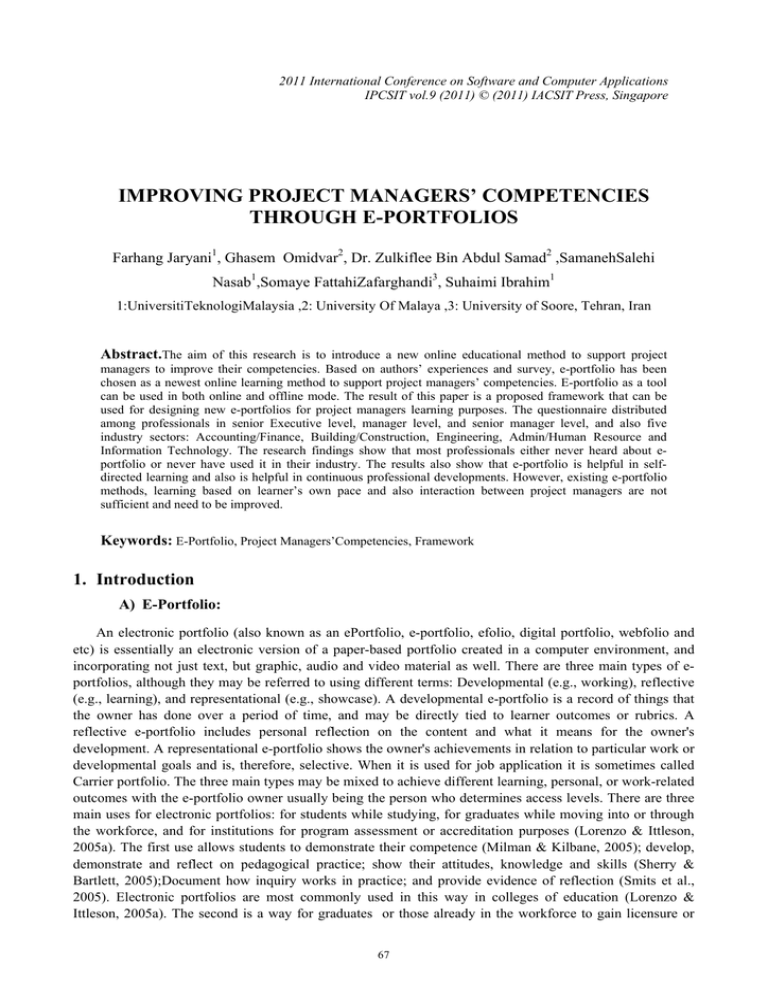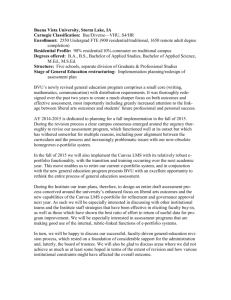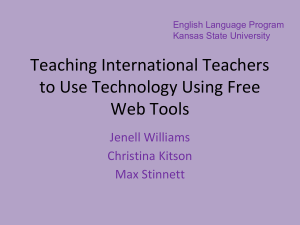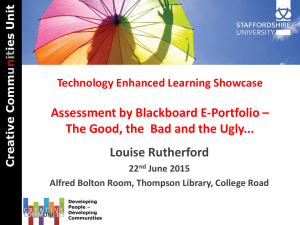IMPROVING PROJECT MANAGERS’ COMPETENCIES THROUGH E-PORTFOLIOS
advertisement

2011 International Conference on Software and Computer Applications IPCSIT vol.9 (2011) © (2011) IACSIT Press, Singapore IMPROVING PROJECT MANAGERS’ COMPETENCIES THROUGH E-PORTFOLIOS Farhang Jaryani1, Ghasem Omidvar2, Dr. Zulkiflee Bin Abdul Samad2 ,SamanehSalehi Nasab1,Somaye FattahiZafarghandi3, Suhaimi Ibrahim1 1:UniversitiTeknologiMalaysia ,2: University Of Malaya ,3: University of Soore, Tehran, Iran Abstract.The aim of this research is to introduce a new online educational method to support project managers to improve their competencies. Based on authors’ experiences and survey, e-portfolio has been chosen as a newest online learning method to support project managers’ competencies. E-portfolio as a tool can be used in both online and offline mode. The result of this paper is a proposed framework that can be used for designing new e-portfolios for project managers learning purposes. The questionnaire distributed among professionals in senior Executive level, manager level, and senior manager level, and also five industry sectors: Accounting/Finance, Building/Construction, Engineering, Admin/Human Resource and Information Technology. The research findings show that most professionals either never heard about eportfolio or never have used it in their industry. The results also show that e-portfolio is helpful in selfdirected learning and also is helpful in continuous professional developments. However, existing e-portfolio methods, learning based on learner’s own pace and also interaction between project managers are not sufficient and need to be improved. Keywords: E-Portfolio, Project Managers’Competencies, Framework 1. Introduction A) E-Portfolio: An electronic portfolio (also known as an ePortfolio, e-portfolio, efolio, digital portfolio, webfolio and etc) is essentially an electronic version of a paper-based portfolio created in a computer environment, and incorporating not just text, but graphic, audio and video material as well. There are three main types of eportfolios, although they may be referred to using different terms: Developmental (e.g., working), reflective (e.g., learning), and representational (e.g., showcase). A developmental e-portfolio is a record of things that the owner has done over a period of time, and may be directly tied to learner outcomes or rubrics. A reflective e-portfolio includes personal reflection on the content and what it means for the owner's development. A representational e-portfolio shows the owner's achievements in relation to particular work or developmental goals and is, therefore, selective. When it is used for job application it is sometimes called Carrier portfolio. The three main types may be mixed to achieve different learning, personal, or work-related outcomes with the e-portfolio owner usually being the person who determines access levels. There are three main uses for electronic portfolios: for students while studying, for graduates while moving into or through the workforce, and for institutions for program assessment or accreditation purposes (Lorenzo & Ittleson, 2005a). The first use allows students to demonstrate their competence (Milman & Kilbane, 2005); develop, demonstrate and reflect on pedagogical practice; show their attitudes, knowledge and skills (Sherry & Bartlett, 2005);Document how inquiry works in practice; and provide evidence of reflection (Smits et al., 2005). Electronic portfolios are most commonly used in this way in colleges of education (Lorenzo & Ittleson, 2005a). The second is a way for graduates or those already in the workforce to gain licensure or 67 registration (Milman & Kilbane, 2005; echeone, Pigg, Chung, & Souviney, 2005);to showcase their qualifications and competencies in job interviews, for appraisal, or for promotion (Milman & Kilbane, 2005); as well as for critical reflection and learning purposes (Lorenzo & Ittleson, 2005a). The third use is as a vehicle for institution-wide reflection, learning and improvement to demonstrate institutional accountability, to make accreditation processes more visible, and to show collective student progress (Lorenzo & Ittleson, 2005a). A.1) Various Portfolio Purposes There are three general purposes for developing portfolios: Learning (Formative) Portfolios, which usually occurs on an ongoing basis supporting professional development; Assessment (Summative) Portfolios, which usually occurs within the context of a formal evaluation process; and Employment (Marketing) Portfolios, which are used for seeking employment (Hartnell-Young & Morriss, 1999). There are Working Portfolios, Showcase or Best Works Portfolios and Assessment Portfolios. As noted above, portfolios can be a form of alternative assessment. The terms alternative assessment, authentic assessment, or performance-based assessment are often used synonymously "to mean variants of performance assessments that require students to generate rather than choose a response" (Herman, Aschbacher, and Winters, 1992, p. 2). The characteristics of this type of assessment are: the student is involved in meaningful performance tasks; there are clear standards and criteria for excellence; there is an emphasis on metacognition and self-evaluation; the student produces quality products and performances; there is a positive interaction between assessor and assessee (Burke, 1999). There are two central features to alternative assessments: "First, all are viewed as alternatives to traditional multiple-choice, standardized achievement tests; second, all refer to direct examination of student performance on significant tasks that are relevant to life outside of school" (Worthen, 1993, p. 445).Kay Burke (1999) and Robin Fogarty (1998) advocate a balanced approach to assessment, with a focus on three components:Traditional Assessment, with a focus on grades and rankings, knowledge, curriculum, and skills, implemented through classroom assessments (tests, quizzes, homework assignments), and standardized tests (either norm-referenced or criterion-referenced)Performance Assessment, with a focus on observable results and standards, application and transfer, implemented through standards, tasks, criteria and scoring rubrics.Portfolio Assessment, with a focus on growth and development over time, implemented through selection, reflection and inspection of classwork, along with goal-setting and self-evaluation B) B.Learning in Project Management Organizations in order to develop their personnel and of course their project managers skills need to engage them in problem solving, decision making and allow them to come up with new ideas in working groups. Project managers through this learning method can improve their collaboration, communication and critical thinking skills. Keser and Karahoca (2010) in their research mentioned the aforementioned approach as an interactive education tool which can be used in project management courses.Another way for advancing project managers knowledge is applying post-project review. “Post Project Review” enhances the body of knowledge in organization. In a research conducted by Anbari, Carayannis, and Voetsch in 2008 the importance of post-project review in future project success and also organizational competitiveness is highlighted. Furthermore, the planned changes in organizations need a lot of people to be involved (Kotter, 2007; Schifalacqua et al. 2009). By involving the project manager’s in the process of planned changes in organization they would be motivated to the changes. In order to facilitate the process of planned changes in organization the method of “Action Learning” can be applied. In this method, project managers in order to improve their performance try to study their own actions and experiences. On the other words they review the actions they have taken and discuss about the results of their actions and based on the results of the discussion, they can identify the best actions for adaption to the planned changes in organization. Therefore, learning process in organizations not only helps them to develop more competent personnel and project managers who have the abilities of decision making, critical thinking, and a sense of collaboration and communication with other project team members, but also increases the body of knowledge in the organization as a strong tool for future project success and organizational competitiveness and also helps for adaption to the changes in organization to be matched with the market demands. 68 2. Importance of the Research As it is acknowledged by leading project management institutes such as Project Management Institute (PMI), International Project Management Association (IPMA), Australian Institute of Project Management (AIPM), and Association for Project Management (APM), achieving competency is a continuous activity for project managers. Thus, achieving competency needs a continuous improvement process. Through a continuous improvement process, project managers not only would be ready for more challenging projects like complex projects, but also they can widen and deepen their competencies to grow to higher management levels such as Project Director Level or even Executive Project Director Level.By applying e-portfolio as a tool for continuous improvement process in organizations, both project managers and organizations can benefit from its advantages. From individual’s perspective, it helps project managers to expand their technical and project management knowledge. Moreover, project managers also can develop their knowledge and experience in other required competency aspects such as job-related competencies, contextual competencies, and personal characteristics. From organizations perspective, e-portfolio helps them for updating their personnel and of course project managers’ knowledge to have more knowledgeable personnel. In addition, through applying e-portfolio, organizations can achieve solutions for problems they are facing with, and also the tacit knowledge can be shared among organizations from one organization to another one. Furthermore, in one hand, through applying e-portfolio, organizations senior management such as CEOs can highlight the mission and vision of organization to all personnel and they can make sure there is a common understanding among all personnel about organization short-term and long-term objectives; and on the other hand, personnel can transfer their ideas and comments about organization issues in a active way to higher management. 3. Research Methodology In this study in order to evaluate the role of portfolio in project manager's competencies, two phases are defined. In the first research phase, experts’ recognition about e-portfolio and also the usage of e-portfolio in their workplace is evaluated. The questionnaire distributed between 730 professionals in senior Executive level, manager level, and senior manager level, and also five industry sectors: Accounting/Finance, Building/Construction, Engineering, Admin/Human Resource and Information Technology. Totally 374 usable responses were obtained. The results show that around 84 percent either have never heard about eportfolio or never have used it in their industry. Only 48 professionals or around 16 percent have used it before in their workplace. Then the advantages of using e-portfolio in workplace from those 58 professionals who has used e-portfolio before were asked. The result shows that respondents strongly believed that using e-portfolio is helpful in self-directed learning and also helpful in continuing professional development. However, respondents believed that in the existing e-portfolio methods, interaction between project managers and also learning based on learner’s own pace and requirements are not sufficient. In the second research phase, based on literature review, previous experiences in project management, senior software experts’ suggestions, and also the analysis of the study, a framework which suggests e-portfolio supports on project manager’s competency components is proposed. 1:Demographic Profile of Respondents 69 4. Propoosed Fram mework In ordeer to enhancce the projecct managers’ competenccies in threee main categgories of peerson-relatedd competencies, job-relateed competenncies and also contextuall competenciies e-portfoliio as a new tool is used.. For instancce for promooting projecct manager’ss competenccies in projeect managem ment and also technicall competencies can use knowledge sharing andd simulated virtual skillss, for improoving projecct manager’ss m software, s forr job-relatedd competenccies can usee personal chharacteristicss can use edducational multimedia online standdards, for coontextual com mpetencies can c use educcational softtware, onlinee updated orrganization’ss policies, andd online bilaateral relationns between project p manag gers and supppliers. 5. Furth her Workss Based on o this reseearch still yett e-portfolio could be mo ore developeed, using Inttelligence techniques wee support ourr portfolio to be more sm mart and be more m effectiive and efficient for Project Managerrs.Moreover,, having onlinne communiity such as Social S Netwoorks would support projeect managerss to share theeir ideas andd their knowledge and exppand their exxperience thrrough virtual communitiees. 6. Ackn nowledgem ment This ressearch is spoonsored by thhe ministry of higher education in colllaboration w with Universiiti Teknologii Malaysia. 7. Referrences [1] Anbbari, F. T., E. G. G Carayanniss, et al. (2008)). "Post-projecct reviews as a key project management com mpetence."Tecchnovation 28((10): 633-6433. [2] Barrrett, Helen (20000, April). Create C Your Own O Electronicc Portfolio. Leearning & Leaading with Technology Voll. 27, No. 7, pp. 14--21 [3] Burrke, K. (1999). How to Asseess Authentic Learning. Arllington Heighhts, IL: Skylighht Professionaal Devvelopment. [4] Foggarty, R. (19988). Balanced Assessment. A A Arlington Heig ghts, IL: Skyliight Professionnal Developm ment [5] Harrtnell-Young, Elizabeth andd Morriss, Mauureen (1999).D Digital Professsional Portfollios for Chang ge. Arlington Heigghts: Skylightt Professional Developmentt [6] Herrman, J. L., Asschbacher, P.R R., &Winters, L. (1992). A practical guidde to alternativve assessmentt. Alexandria, VA: Association for Supervisioon and Curricculum Develop pment. m e e-course by ussing project baased [7] Kesser, H. and D. Karahoca (20010). "Designiing a project management learrning." Proceddia - Social and Behavioral Sciences 2(2): 5744-5754. 70 [8] Kotter, J.P., 2007. Leading change. Harvard Business Review 85, 96–103. [9] Lorenzo, G., & Ittleson, J. (2005a). An overview of eportfolios.Retrieved July 14, 2006, http://www.educause.edu/LibraryDetailPage/666?ID=ELI3001 [10] Milman, N. B., & Kilbane, C. R. (2005). Digital teachingportfolios: Catalysts for fostering authentic professionaldevelopment. Canadian Journal of Learning andTechnology,31(3), online version. [11] Pecheone, R. L., Pigg, M. J., Chung, R. R., & Souviney, R.J. (2005). Performance assessment and electronic portfolios:Their effect on teacher learning and education. The ClearingHouse, 78(4), 164-176. [12] Sherry, A. C., & Bartlett, A. (2005). Worth of electronic portfolios to education majors: A 'two by four' perspective. Journal of Educational Technology Systems, 33(4), 399-419. [13] Schifalacqua, M., C. Costello, et al. (2009). "Roadmap for Planned Change, Part 1: Change Leadership and Project Management." Nurse Leader 7(2): 26-29, 52. [14] Smits, H., Wang, H., Towers, J., Crichton, S., Field, J., &Tarr, P. (2005). Deepening understanding of inquiryteaching and learning with e-portfolios in a teacherpreparationprogram. Canadian Journal of Learning and Technology,31(3), online version. [15] Worthen, B. R. (1993, February). Critical issues that will determine the future of alternative assessment. Phi Delta Kappan, pp. 444-456. 71



